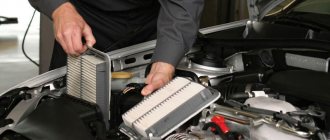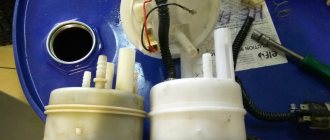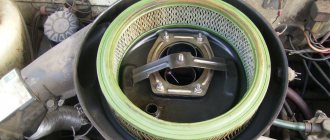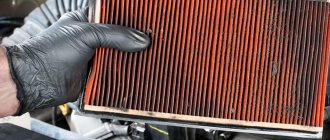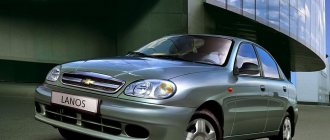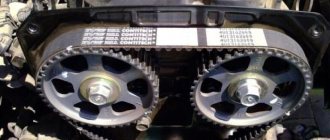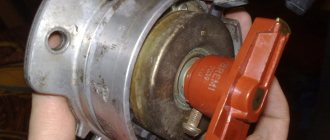12.07.2019
| (No votes) |
Issues discussed in the material:
- Why do you need an air filter in a car?
- When to change the air filter in a car
- Which air filter to choose
- Is it possible to clean the air filter in a car?
At the dawn of the automobile industry, there were no filters at all. Manufacturers had one task - to ensure that the car simply drove. Over time, designers had to think about extending the engine's service life, and today each model is equipped with a special cleaning element. In order to properly monitor its condition, it is important to know why the air filter in a car is needed, how to determine when it is time to replace it, and whether cleaning is possible.
What is an air filter for?
The engine air filter is a structural element of the engine power system, which is responsible for filtering the incoming air into the combustion chambers.
As you know, not a single internal combustion power unit can function without air, which enters through the throttle (in new cars) or through the intake manifold (carburetor-type engines). The filter element is designed to filter the incoming air into the combustion chamber. This oxygen must be clean, free of dust and dirt. It is this part that is responsible for ensuring that the air entering the engine is clean. Historically, there are different types of filters, which will be described below. They all have a different design, but their purpose remains the same.
How to quickly warm up a car in cold weather
Published: 01/06/2019
Spread the love
Spread the love How to warm up a car in winter when it's cold Contents 1 How to warm up a car when it's cold in winter 1.1 Is it necessary to warm up a car in winter before driving? 1.1.1 The following arguments speak about the benefits and necessity of warming up the car: 1.1.1.1 Thick motor oil 1.1.1.2 Safety 1. 1.1.3 Engine wear 1.1.1.4 Fuel consumption 1.1.1.5 Car interior 1.2 How to properly warm up a car in winter? 1.2.1 The procedure for warming up a car in winter is as follows: 1.2.1.1 Preparation ...
How to quickly warm up a car in cold weather Read more »
Design features
Most air filters consist of three elements: a housing, a filter membrane and a rubber seal, which is located along the contour to prevent dust and dirt from passing between the housing and the filter element itself.
The filter is placed in a special housing, which has an inlet for air intake and an outlet that leads to the combustion chambers. Depending on the design of the car and the manufacturer, the filter housing may have different sizes, layout, and location of structural elements. There are mainly round and rectangular housings and filters themselves.
avtoexperts.ru
For every hundred kilometers traveled, a car consumes 12-15 m3 of atmospheric air. The dust and dirt particles it contains enter the engine and lead to malfunctions and breakdowns. This process can be prevented by an air filter, which, in addition to direct cleaning, also reduces the noise level in the intake tract and stabilizes the temperature of the fuel in gasoline engines.
Air filter
Over time, the filter becomes clogged and begins to pass less air. This leads to partial combustion of the mixture and a weakening of engine power. The car requires more fuel, and the content of toxic substances in the exhaust gases increases.
Important to remember! Timely replacement of the air filter extends the life of the engine and maintains its power. Monitoring the level of contamination of the cleaning element becomes a mandatory procedure for the car owner.
Types of air filters
Modern air purification devices are presented in the 4 most common versions:
1. Cylindrical shape. 2. Panel. 3. Round. 4. Frameless.
Cylindrical filters
Cylindrical devices are used for engines of large-sized vehicles (KAMAZ brand, buses, special equipment for agricultural purposes and for road work). Such filters have a high throughput required for engines with high fuel consumption. You can extend the life of the air device by using a fabric filter placed on it (for example, a piece of gauze of sufficient density).
cylindrical filter for special equipment
Until recently, clogged paper filters were washed and reinstalled in the engine power system. As practice has shown, in terms of monetary costs, this method is not inferior to purchasing a new filter. In addition, the quality of the device is significantly reduced. For this reason, most car owners refused to wash filters, preferring to replace the part.
Round filters
Round air filters have a smaller size and flow capacity. They are installed in carburetor-type passenger cars. The devices are suitable for small displacement engines. Round filters are more popular than panel cleaning devices, although their technical and operational characteristics are significantly lower.
Panel filters
Panel devices are designed for passenger car engines of any type. The filters are made in the form of a rectangle, the air passes through a paper corrugation hidden behind a plastic or metal grille, and seals are installed along the contour. Panel filters are more expensive than round filters, but at the same time they have more efficient throughput and longer service life.
The most common modern air filters
Frameless filters
Frameless filter devices do not have a grille. Like panel devices, they are equipped with paper corrugation and rubber or foam seals.
Before the advent of these filter elements, various materials were used to clean the air entering the engine: horsehair, wire mesh, polystyrene foam, etc.
Dry type filters
Currently, “dry” type filters have gained popularity. The principle of their operation is simple: a cartridge is placed in a plastic box. A sheet of paper with a special porous surface that is resistant to soaking and capable of holding the smallest particles of dust is inserted into it.
The carburetor engine is equipped with a round/oval shaped box and the same cartridge; accordingly, the filter in the cartridge frame will look like the letter “O”. Injection engines require rectangular cartridges with paper corrugations of the same shape installed in them. All types of cartridges have replaceable filters.
Cardboard is most often used for air filtration, but in a number of countries synthetic material is used for this purpose. In this case, it is necessary to constantly monitor the condition of the filter.
How often should the filter be changed?
There are approximate terms for replacing the filter, but it all depends on the degree of contamination. The car owner can easily check this when inspecting the device: dirt and oil stains indicate that the filter’s throughput has dropped and it’s time to change it.
On average, the need for a new cleaning element occurs every 15-30 thousand kilometers traveled by a car. Having covered this distance, the vehicle owner can change the filter or check the data in the registration certificate (it contains a mark indicating the end of the filter’s service life and its replacement).
dirty and clean filters. It is better to avoid such contamination, so check more often.
You can simultaneously install a new filter and change the oil when the car has traveled 10-15 thousand kilometers, or do it every other time in order to save money. A visual check allows you to correctly assess the condition of the device and replace it at the right time.
It is important to know! In diesel engines with a turbocharging function, the filter becomes dirty faster, so its service life is relatively short, and the condition of the device must be constantly monitored.
Do not wash the dirty filter the old fashioned way and reuse it. Water will wash away the top layer of dirt, but will not remove particles embedded in the filter element. The device will be visually clean, but the throughput will not be restored.
It must be remembered that saving on a new filter risks resulting in a drop in power or engine breakdown. Timely replacement of the filter guarantees effective purification of the air before it enters the engine and a reduction in the concentration of toxins in the exhaust gases.
You can read about the cabin filter here
Types of air filters
Paper air filters
Air filters are divided according to the composition of the filter membrane. There are several options for making filter “fabric”:
- Paper
. Quite common on old cars of domestic and foreign production. This type can be found on old Zhiguli and Volga cars. It was considered quite effective until the mid-90s of the 20th century. - Cotton
. It began to gain popularity among car manufacturers in the 90s. It replaced paper because it could easily let air through even when clogged. - Fibrous type
. One of the most common options because it perfectly filters polluted air. Of course, there is a limit to everything, so you should adhere to the fact that filters must be changed in due time. - Carbon filters
. They have become quite common recently, because in addition to filtration, they also saturate the engine with the necessary oxygen. Also, they filter not only dust and dirt, but also gases with which the air is saturated.
I filled up with gasoline instead of diesel, what should I do?
Published: 06/05/2019
Spread the love
Spread the love I filled up with gasoline instead of diesel, what should I do? Contents1 I filled up with gasoline instead of diesel, what should I do? 1.0.1 Gasoline in a diesel engine 1.1 Gasoline in a diesel engine - how to deal with it? 1.2.2 Filled up an old car with gasoline instead of diesel1.2.3 Beware of biofuels Errors when refueling happen quite often, since in Russia every year...
I filled up with gasoline instead of diesel, what should I do? Read completely "
Principles of replacing the air filter
Replacing the engine air filter is a fairly simple process. As practice shows, most motorists try to perform this procedure on their own, without resorting to the help of a car service.
Many motorists ask the question: how often does it need to change the engine air filter? The answer is quite simple: according to the technical documentation of the car, as well as the recommendations of the manufacturer. As a rule, the period for replacing an engine air filter is 15-20 thousand kilometers.
How to change the air filter (step by step instructions):
- Remove the top cover.
- We take out the filter.
- We install a new filter element.
- We close the case.
Based on the short replacement instructions, you can understand that replacing the air filter is a simple process that will not take much time.
How to spot a fake
To avoid purchasing a low-quality product, just carefully inspect the case. Branded products have special markings, which include a serial number and a list of main characteristics. If there is no marking, this is a counterfeit product.
Check the quality of the thread. This is an important part of the design and a good manufacturer knows this. The presence of nicks, burrs, chips, scratches, roughness, etc. indicates a low-quality product.
Pay attention to the packaging. Self-respecting brands deliver goods to store shelves in boxes made of thick cardboard that do not lose their shape during transportation. Soft packaging or its absence indicates a fake.
The product inside the box is placed between foam plastic for better fixation and protection from damage. If instead you saw a pile of paper or cut cardboard, this is a counterfeit product.
Well-known brands also place a seal with a hologram or QR code on their products, which, when read, will take you to the manufacturer’s official website. The absence of such security elements is a clear sign of counterfeit.
Filters for sports cars
Everyone knows that old American sports cars are structurally different from other cars.
But not everyone knows that they have open-type air filters. This is due to the fact that the engine must breathe a large amount of air. On some older muscle cars, the air filter element does not have an outer housing, but only has an upper and lower plate that cover the filter. With such power and torque, a large amount of air is needed. It was these filters that could provide the required amount of oxygen for the formation of an air-fuel mixture.
“I’ll wash the filter with turpentine, it will cost me nothing” and other interesting ideas
Research institutes, scientific and technical laboratories, hundreds of thousands of dollars - all just to improve the quality of car parts a little more. And yet, you can still find recommendations to “update” the air filter instead of changing it. But why can’t it be cleaned (vacuumed, beaten against wood, washed in a basin, washed in a washing machine and soaked in oil)?
The answer to this question is given by the structure of the filter paper itself. Large particles stuck in the upper layers of the filter are visible to the naked eye. Because they are on the surface, they are easy to remove, leaving the filter appearing almost clean.
But the most harmful micron-sized detail remains in the deep layers of the filter, and it is impossible to knock dirt out of them by any means. In the best case, after such manipulations, gasoline consumption will simply increase (immediately after cleaning, the engine consumes 10% more fuel!). At the next stage, the dust entering the filter will completely clog the pores, after which the filter will stop allowing air to pass through at all. And finally, due to exceeding the maximum permissible resistance, the air flow will rupture the filter with all the ensuing consequences: dirty air gets inside, damaging the mass air flow sensor and the engine.
Some car owners try to improve the quality of filtration by soaking the filter in oil (similar to “zero” filters). The result of such a modification is predictable: the oil instantly clogs all the pores of the filter, after which air stops passing through it altogether.
All, absolutely all paper filters are disposable, having a strictly defined service life and conditions of use. There is only one way to improve the filter in your car: buy and properly install a new, high-quality one.
Economically
Tuning options
Many modern car enthusiasts are tuning their cars, and therefore engine improvement is inevitable. One of the elements of modernization is the air filter. Over the last 10 years, no new innovations have been made in this improvement, so two types of filter elements are used:
- Zero resistance. This filter does not have air resistance, unlike the standard type, which allows more air to enter the combustion chamber.
- Direct flow type. These filters resemble “nuliviks” in their design features, but the essence of the design is slightly different. There are several membranes with different permeability, which makes it possible to more effectively filter the air that enters the combustion chamber.
What is the volume of the VAZ cooling system
Published: 10/04/2017
Spread the love
Spread the love Pictures of VAZ cooling system VAZ Contents1 Pictures of VAZ cooling system VAZ1.1 Volume of the VAZ cooling system 21141.2 Volume of the VAZ cooling system 21071.3 Volume of the VAZ cooling system 21101.4 Volume of the VAZ cooling system 21231.5 Largus cooling system During engine operation, a lot of heat is generated, the cylinder of our engine can heat up to several hundred degrees Celsius. For that …
What is the volume of the VAZ cooling system Read more »
The difference between filters
Many car enthusiasts begin to confuse filters, especially for modern foreign cars.
Particular confusion arises with the cabin filter. It is worth understanding that the air filter elements in the cabin and the engine are different, they have different catalog numbers and even sizes. Cabin filter
is a filter element that is installed in the car interior to filter heating and ventilation air, and in no way relates to an engine element such as an air filter. Therefore, before buying a filter, you need to understand exactly where it is installed.
What are there
Filter elements are available in three design types: cylindrical, panel and frameless.
Let us note the features that are directly related to operation. Cardboard is a common material for air filters. But in some countries, replacement elements are made from synthetic fibers. Their operation requires strict adherence to replacement intervals.
On sports cars, filters are made of five-layer gauze soaked in “branded” oil. Compared to cardboard ones, they have much lower initial resistance. In addition, after special treatment they can be reused.
Innovations
As always, let's look at some innovations.
One of these is the air filter sensor, which is responsible for the contamination of this element. The first implementation and testing was carried out in 2015 on cars with a hybrid engine - the Dodge Challenger from GM. The first tests showed that this sensor has shortcomings, but improvement continues. The difference between this device and the mass air flow sensor is that it analyzes the quantity and quality of air immediately after the filter and indicates the condition of the product, as well as when it needs to be replaced. Many car enthusiasts will say that this is a pointless feature, but one by one, automakers are picking up this idea and developing their own innovations in this unit.
How to extend the life of a modern engine?
Published: March 17, 2019
Spread the love
Spread the love How to extend the life of a modern engine? Today's cars are very complex - and it's not just the electronics! They are simply the fruit of decades (and sometimes hundreds of years) of work by engineers. And the overwhelming majority deserve the name of the top products of technical civilization. Obviously expensive because you have to pay for quality and modernity... But...
How to extend the life of a modern engine? Read completely "
Operating principle, purpose
Why does a car need an air filter? The filter element cleans the incoming air from harmful impurities and protects the motor from clogging. For complete combustion of fuel in an internal combustion engine, it is necessary that the air content in the combustible mixture be up to 20 times greater than fuel. The air outside the car contains dust particles, seeds of various plants, and so on; if these components get to the engine, they will begin to act as abrasive elements and accelerate engine wear.
In addition to its main purpose - cleaning the air from small dust particles, the drive air filter performs the following functions:
- in gasoline engines, the filter device acts as a temperature regulator of the combustible mixture;
- noise suppressor;
- provides maximum resistance to intake air.
The operating principle of the filter device is as follows: the incoming air flow passes through the filter, small particles are retained by the filter element, and the purified air flows to the intake manifold.
Watch a video on how to choose a filter element:


